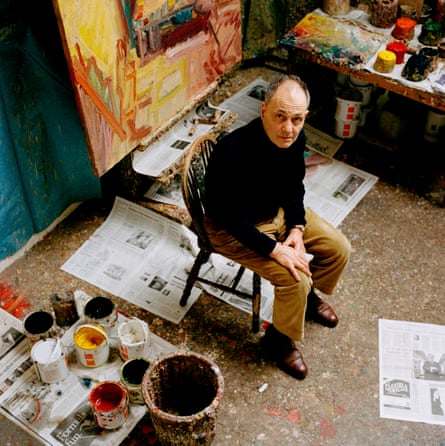 |
| Frank Auerbach |
Frank Auerbach, leading figurative painter who fled Nazis, dies aged 93
Saved by the Kindertransport scheme, the artist later fell in with Soho’s artistic crowd including Francis Bacon and Lucian Freud
Tim Jonze
Tuesday 12 November 2024
Frank Auerbach, the artist who arrived in Britain under the Kindertransport scheme and went on to become one of the most significant figurative painters of the postwar era, has died aged 93.
Over a career spanning seven decades, the British-German artist was known for his portraiture, as well as street scenes of Camden in north London where he kept the same studio for 50 years. He was also known for the unique way in which he created his work – repeatedly scraping the paint from versions he was dissatisfied with and starting again until the finished work could be so laden with paint that it threatened to wobble off the canvas.
 |
| Frank Auerbach |
He once estimated that 95% of his paint ended up in the bin. “I’m trying to find a new way to express something,” he once told the Guardian. “So I rehearse all the other ways until I surprise myself with something I haven’t previously considered.”
Geoffrey Parton, director of Auerbach’s gallery Frankie Rossi Art Projects, said: “Frank Auerbach, one of the greatest painters of our age, died peacefully in the early hours of Monday 11 November at his home in London. We have lost a dear friend and remarkable artist but take comfort knowing his voice will resonate for generations to come.”
Auerbach was born in Berlin, Germany, in 1931 but arrived in Britain eight years later under the Kindertransport scheme. His father, an engineering patent agent, and mother, who trained as an artist, were both murdered in the concentration camps at Auschwitz. He attended Bunce Court in Kent, a progressive boarding school for Jewish refugee children, where his talent for art and drama shone through. In 1947 Auerbach became a naturalised British subject and a year later began his formal training in London – St Martin’s School of Art in the day, with extra night classes taken at Borough Polytechnic. During this time he took a role in the then 19-year-old Peter Ustinov’s debut play, House of Regrets, but painting would become his true calling and he continued his studies at the Royal College of Art.
Auerbach fell in with Soho’s artistic crowd, which included Francis Bacon and Lucian Freud: when the latter died in 2011, a proportion of his vast Auerbach collection was given to the British government in lieu of £16m death duties.

In 1956 Auerbach received his first solo exhibition at London’s Beaux Arts Gallery. Some visitors were unimpressed with his excessive application of paint but he found a fan in critic David Sylvester who called it “the most exciting and impressive first one-man show by an English painter since Francis Bacon in 1949”.
Surviving the war was a key influence on Auerbach; he would journey through the capital’s bomb sites and feel an urge to capture the scenes; to somehow document the nation’s collective trauma. Auerbach developed similarly intense relationships with his sitters and preferred to paint only a small circle of friends and family, chief among those his wife, the painter Julia Wolstenholme, the model Juliet Yardley Mills and Estella Olive West, with whom he had a romantic relationship that contributed towards him separating from Wolstenholme. His studio was reportedly cramped and cold, with Auerbach turning the oven on during winter to keep it habitable. To sit for him could be an endurance in itself: the weekly two-hour sessions could go on for a year while Auerbach painted, scraped and repainted. “Rather like going to the dentist,” one sitter reported.
After years of struggling financially, things picked up for Auerbach in later life. In 1978 he was the subject of a major retrospective at the Hayward Gallery in London, with the curator Catherine Lampert becoming a regular sitter for several decades afterwards. He represented Britain at the Venice Biennale in 1986, sharing the Golden Lion prize with the German artist Sigmar Polke.
In 2015 London’s Tate Britain staged a major retrospective of Auerbach’s work alongside the Kunstmuseum Bonn. His painting Head of Gerda Boehm fetched more than $5m in 2022.
Auerbach frequently referenced art history in his work and liked to discuss insights on his heroes: Constable, Titian, Tintoretto and Veronese. There was certainly something old-fashioned about Auerbach’s approach – in an age of international travel and glitzy art openings, he would rarely leave his patch of north London. He was a self-confessed workaholic. While under lockdown restrictions during the Covid-19 pandemic, the 91-year-old took to painting self-portraits.
Auerbach had a son, the film-maker Jake Auerbach, with Wolstenholme, and after his relationship with West finally ended he began living with his wife again at weekends. Often, though, he was at his happiest alone with his canvas. “I sometimes think of doing other things,” he said to the Guardian in 2015, “but actually it’s much more interesting to paint.”


No comments:
Post a Comment